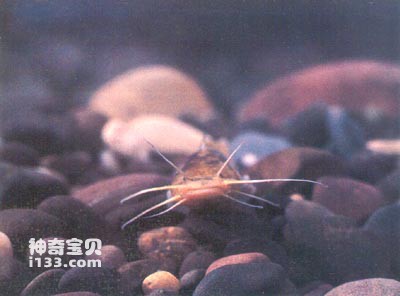Liobagrus kingi belongs to the order Liobagrus, family Liobagrus, and is commonly known as: Liobagrus kingi. English name: King’s bullhead.
Endangerment level: Endangered.
The body is long, the sides are flat, the dorsal edge is arched, and it slopes upward from the snout to the back. It slopes slightly downward behind the dorsal fin, and the ventral surface is straight before the pelvic fin. The head is slightly shorter. The snout is blunt, rounded, flat, and the tip of the snout is almost straight. The mouth is large, terminal, and transversely cleft. Both jaws and vomer have teeth, and the premaxillary denticle is in the shape of a single piece; the mandibular denticle is meniscus-shaped and is divided into two adjacent left and right pieces; the palatine bone has no teeth. There are 4 pairs of barbels, 1 pair of nasal barbels, 1 pair of chin barbels, 2 pairs of chin barbels, the chin barbels extend to the pectoral fin base, and the front mandibular barbels are shorter. The eyes are small, dorsally positioned, and have blurred eye rims. The gill pores are large and the gill membranes are free. The body has no scales and lateral lines. The head and fins are rich in thick skin. The adipose fin is long, the starting point is not very obvious, and the rear end is separated from the caudal fin by a shallow notch. The pectoral fins have short hard spines, and there are 3-4 serrated teeth on the trailing edge near the base, with venom glands at the base. The rear edge of the pectoral fin is rounded and convex. The outer edge of the anal fin is rounded and convex; the caudal fin is rounded. The whole body is brownish gray with scattered irregular brown spots, the fins are yellow, and the center of the back and tail fins are black.
It is a small carnivorous fish that lives on the bottom of rapids with rocky bottoms. The individual is small and has no economic value.
Yangsi fish is a specialty fish in my country and is only distributed in Dianchi Lake in Yunnan Province. Before the 1960s, it was relatively common, but not in large numbers. In recent decades, due to the rapid increase in population, excessive discharge of domestic and industrial sewage into the lake has seriously polluted the lake. Secondly, from the late 1950s to the early 1970s, large-scale land reclamation of the lake has destroyed the life of fish. Factors such as the environment and spawning environment have significantly reduced the number of this species, and it has not been found again for many years.

animal tags:
We created this article in conjunction with AI technology, then made sure it was fact-checked and edited by a Animals Top editor.